
 
Chapter IV Falun Gong Practice System
Falun Gong is a special cultivation practice in the Buddha
School. Its uniqueness distinguishes itself from other regular cultivation
methods of the Buddha School. Falun Gong is an advanced cultivation practice
system. In the past, it served as an intensive cultivation method that
required practitioners with extremely high Xinxing (mind-nature) or
great inborn quality. For this reason, this cultivation practice system is
hard to popularize. However, in order for more practitioners to improve their
levels, to know about this cultivation system, and also to meet the demands of
numerous devoted practitioners, I have compiled a set of cultivation exercises
suitable for the public. In spite of the modifications, these exercises still
far exceed average cultivation systems in terms of what they offer and the
levels at which they are practiced.
Falun Gong practitioners not only can quickly develop their
energy potency and supernormal capabilities, but also can acquire a Falun (law
wheel) that is incomparable in power in a very short period of time. Once
formed, the Falun rotates automatically in a practitioner’s lower abdomen at
all times. It incessantly collects energy from the universe and transforms it
into Gong (cultivation energy) in a practitioner’s Benti (true
being). Thus, the goal of "the Fa (law) refines the
practitioner" will be achieved.
Falun Gong consists of five sets of movements, which
are Buddha Showing A Thousand Hands Exercise, Falun Standing Stance Exercise,
Penetrating the Two Cosmic Extremes Exercise, Falun Heavenly Circulation
Exercise and Way of Strengthening Divine Powers Exercise.
1. Fozhan Qianshou Fa (Buddha Showing A
Thousand Hands Exercise)
Principle:
The Buddha Showing A Thousand Hands Exercise is centered
around stretching to open up all energy channels. After practicing this
exercise, beginners will be able to acquire energy in a short period of time
and experienced practitioners can quickly improve. This exercise requires all
energy channels to be opened up at the outset, enabling practitioners to
immediately practice at a very high level. The movements of this exercise are
quite simple because Great Tao, as a rule, is simple and easy to learn. Though
the movements are simple, on the macro-level they control many things evolved
by the entire cultivation system. When practicing this exercise, one’s body
will feel warm, and experience a unique sensation of there being a very strong
energy field. This is caused by stretching and opening all the energy channels
in the entire body. Its purpose is to break through areas where the energy is
blocked, to enable energy to circulate freely and smoothly, to mobilize the
energy within the body and under the skin, circulating it vigorously, and to
absorb a great amount of energy from the universe. At the same time, it
enables the practitioner to quickly enter the state of having a Qigong energy
field. This exercise is practiced as the basic exercise of Falun Gong and is
usually done first. It is one of the methods to strengthen cultivation.
Kou Jue (Verse recited once right before the exercise)
Shen Shen He Yi, Dong Jing Sui Ji
Ding Tian Du Zun Qian Shou Fo Li
Preparation:
Relax the entire body but not too loose. Stand naturally
with feet shoulder-width apart. Bend the knees slightly. Keep the knees and
hips relaxed. Pull your chin in slightly. The tip of the tongue touches the
upper palate. Leave a little space between the teeth. Close the lips and
gently shut the eyes. Maintain a serene expression on the face. During the
practice you will have the feeling that you are very big and tall.
Liang Shou Jieyin (Conjoin the Hands)
Raise both hands with palms facing up. The thumb tips
slightly touch each other. Join the other four fingers and overlap them on top
of each other. For males, the left hand is on top; for females the right hand
is on top. The hands form an oval shape and are held at the lower abdomen
area. Keep both upper arms slightly forward, with the elbows suspended, so the
underarms are open (as shown in Fig. 1-1).
   
Mi Le Shen Yao (Maitreya Stretching His Back)
Begin with Jieyin (conjoining hands posture). While
raising the conjoined hands, straighten both legs gradually. When the hands
reach the front of the face, separate them and turn both palms upward
gradually. Once the hands are above the top of the head, the palms face up and
the fingers of both hands point to each other at a distance of 20-25 cm (8-10
inches) (as shown in Fig. 1-2). At the same time, push the head upward and
press the feet downward on the ground. Press up hard with the base of both
palms and stretch the body for about 2 to 3 seconds. Then immediately release
the whole body, particularly the knees and hips should return to the relaxed
state.
Ru Lai Guan Ding (Tathagata Filling Energy into the Top
of the Head)
Follow the above posture. Turn both palms outward 140
degrees to both sides simultaneously, so that the inside of the wrists face
each other, forming the shape of a "funnel". Flex the wrists and
move them downward (as shown in Fig. 1-3).
When the hands reach the front of the chest, the palms face
the chest at a distance of about 10 cm (4 inches). Continue moving both hands
down to the lower abdomen (as shown in Fig. 1-4).
Shuang Shou He Shi (Press the Hands Together in front of
the chest)
When reaching the lower abdomen area, immediately lift the
hands up to the chest and He Shi (Figure 1-5). When doing Heshi, fingers and
the base of the palms are pressed against each other, with a hollow space
between the palms. Hold the elbows up, with the forearms forming a straight
line. (Keep hands in the lotus posture, except doing Heshi and Jieyin, this is
the same for the following exercises).
   
Zhang Zhi Qian Kun (Hands Pointing to Heaven and
Earth)
Begin with the posture of Heshi. Separate the two hands 2-3
cm (1 inch) apart and at the same time, start to turn them. Males turn the
left hand (female the right hand) towards the chest and turn the right hand
outwards, so that the left hand is on top and the right hand is at the bottom.
Both hands are in a straight line with the forearms (as shown in Fig. 1-6).
Then, stretch the left forearm diagonally to the upper
left, with the palm facing down until the hand reaches the head level. The
right hand is still at the chest with the palm facing up. As the left hand is
extended, stretch the entire body gradually, push the head upward and press
the feet downward. Stretch the left hand upward in the upper left direction,
while the right hand that is in front of the chest stretches outward together
with the upper arm (as shown in Fig. 1-7). Stretch for about 2 to 3 seconds,
and then immediately release the entire body. Move the left hand to the front
of the chest and Heshi (as shown in Fig. 1-5).
Then turn the palms again. The right hand (female the left
hand) is on top and the left hand is at the bottom (as shown in Fig. 1-8).
The right hand repeats the previous movements of the left
hand, that is, extend the right forearm diagonally upward with the palm facing
down until the hand has reached as high as the head. The left hand is still at
chest with the palm facing upward. After stretching (as shown in Fig. 1-9),
immediately release the entire body. Move the hand to Heshi in front of the
chest (as shown in Fig. 1-5).
Jin Hou Fen Shen (Golden Monkey Splitting Its Body)
Begin with the posture of Heshi. Separate the hands at the
chest and extend them toward the sides of the body forming a straight line
with the shoulders. Gradually stretch the entire body. Push the head upward,
press the feet downward, straighten the two hands forcefully at the sides and
stretch out in four directions (as Fig. 1-10) for 2-3 seconds. Immediately
release the entire body and Heshi (as shown in Fig. 1-5).
  
Shuang Long Xia Hai (Two Dragons Diving into the Sea)
From Heshi, separate hands and extend them down towards the
lower front. When the two arms are parallel and straight, they should form an
angle of about 30 degrees with the legs (as Fig. 1-11). Stretch the entire
body. Push the head upward and press the feet downward. Stretch for about 2-3
seconds. Release the entire body instantly. Draw back the two hands and Heshi.
Pu Sa Fu Lian (Bodhisattva Placing Hands on Lotus)
From Heshi, separate both hands and extend them diagonally
to the sides of the body, with the angle between the arms and the legs at
about 30 degrees (as shown in Fig. 1-12). Stretch the whole body gradually and
the fingertips stretch out downward with a little force. Then, release the
entire body immediately. Move the hands to the chest and Heshi.
Luo Han Bei Shan (Arhat Carrying a Mountain on His Back)
Begin with Heshi. Separate the hands and extend them to the
back of the body. At the same time, turn both palms facing back. When the
hands are passing the sides of the body, flex the wrists slowly. When the
hands reach behind the body, the angle between the wrists and the body is 45
degrees (as shown in Fig. 1-13). Stretch the entire body gradually. After the
two hands reach the proper position, push the head upward and press the feet
downward. Keep the body upright, and stretch for about 2-3 seconds. Release
the entire body immediately. Draw back the hands and return to Heshi.
  
Jin Gang Pai Shan (Vajra Toppling a Mountain)
Begin with Heshi. Separate both hands and push forward with
the palms. The fingers point up. Keep the arms at the shoulder level. After
the arms are straightened, push the head upward and press the feet downward.
Keep the body upright (as shown in Fig. 1-14). Stretch out for 2-3 seconds.
Immediately release the entire body. Put the two hands together in front of
the chest and return to Heshi.
 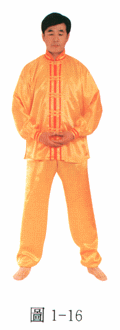
Die Kou Xiao Fu (Overlap the Hands in front of the
Lower Abdomen)
Begin with Heshi. Slowly move the hands downward, turning
the palms to face the abdomen area. When the hands reach the lower abdomen
area, overlap the hands. For males, the left hand is inside, for female, the
right hand is inside. The palm of one hand faces the back of the other. Keep a
distance of 3 cm (1 inch) between the two hands and between the inner hand and
the lower abdomen. It is usual to overlap the hands for 40 to 100 seconds (as
Fig. 1-15). Finish the exercise with Liang Shou Jieyin (as shown in Fig.
1-16).
2. Falun Zhuang Fa (The Falun Standing Stance
Exercise)
Principle:
This is the second set of Falun Gong exercises. It is a
tranquil standing exercise composed of four wheel-embracing movements. The
movements are monotonous, and each posture is required to be held for quite a
long time. Beginners may feel their arms heavy and sore initially. After the
practice, however, their entire body will feel relaxed without feeling any
tiredness that comes from working. As the frequency and length of practice
increases, practitioners can feel a Falun rotating between the two arms.
Frequent practice of the Falun Standing Stance will enable the entire body to
completely open up and enhance the energy potency. Falun Standing Stance is a
comprehensive cultivation method to increase wisdom, upgrade levels, and
strengthen divine powers. The movements are simple, yet much can be achieved
from this exercise and what it practices is all inclusive. During practice, do
the movements naturally. You must be aware that you are practicing. Do not
sway though it is normal to move slightly. As with other exercises of Falun
Gong, the end of this exercise does not mean the end of the practice, because
Falun never stops rotating. The duration of each movement may differ from
person to person; the longer, the better.
Kou Jue (Verse recited once right before the exercise)
Sheng Hui Zeng Li Rong Xin Qing Ti
Si Miao Si Wu Fa Lun Chu Qi
Preparation:
Relax the entire body but not too loose. Stand naturally
with feet shoulder-width apart. Bend the knees slightly. Keep the knees and
hips relaxed. Pull your chin in slightly. The tip of the tongue touches the
upper palate. Leave a little space between the teeth. Close the lips and
gently shut the eyes. Maintain a serene expression on the face. Shuang Shou
Jieyin (conjoin the two hands) (as shown in Fig. 2-1).
  
Tou Qian Bao Lun (Holding the Wheel in front of the
Head)
Start from Jieyin (conjoined hand posture). Slowly raise
both hands from the lower abdomen while separating them. When the hands have
reached the front of the head, the palms are facing the face at the eyebrow
level. The fingertips of both hands point to each other at a distance of 15 cm
(5 inches). The two arms form a circle and the entire body is relaxed (as
shown in Fig. 2-2).
   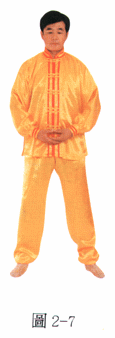
Fu Qian Bao Lun (Holding the Wheel in front of the
Abdomen)
Move both hands gradually downward from the previous
position. Keep the posture unchanged until they reach the lower abdomen area.
Keep a distance of about 10 cm (4 inches) between the hands and the abdomen.
Hold the two elbows forward, keeping the underarms open. The palms face up.
The fingers of both hands point to each others at a distance of 10 cm (4
inches). The arms form a circle (as Fig. 2-3).
Tou Ding Bao Lun (Holding the Wheel above the Head)
From the previous position, raise the hands slowly, keeping
the circular shape of the arms unchanged. Hold the wheel above the head with
the fingers pointing to each other. The palms face downward and keep a
distance of 20-30 cm (8 – 12 inches) between the fingertips of the two
hands. The arms form a circle. Keep the shoulders, arms, elbows and wrists
relaxed (as shown in Fig. 2-4).
Liang Ce Bao Lun (Holding the Wheel on Both Sides of the
Head)
Slowly move the hands downward from the previous position
to the sides of the head. Keep the palms facing both ears, the forearms
upright and the shoulders relaxed. Do not keep the hands too close to the
ears. (as shown in Fig. 2-5).
Die Kou Xiao Fu (Overlap the Hands in front of the Lower
Abdomen)
Slowly move both hands down from the previous position to
the lower abdomen. Overlap the hands (as shown in Fig. 2-6).
Finish the exercise with Liang Shou Jieyin (conjoined the
hands) (as shown in Fig. 2-7).
3. Guantong Liang Ji Fa (Penetrating the Two
Cosmic Extremes Exercises)
Principle:
This exercise is intended to penetrate the cosmic energy
and mix it with the energy inside of one’s body. A great amount of energy is
expelled and taken in. In a very short time, the practitioner can expel the
pathogenic and black Qi from his body and take in a great deal of energy from
the cosmos so that his body can be purified, reaching the state of "a
Pure-White Body" quickly. In addition, while doing the hand movements,
this exercise facilitates the "opening of the top of the head" and
unblocks the passages under the feet.
Before doing the exercise, imagine yourself as two large
empty barrels, standing up between heaven and earth, gigantic and incomparably
tall. With the upward movement of the hands, the Qi inside the body rushes
directly out of the top of the head to the upper cosmic extremes; with the
downward movement of the hands, it goes out through the bottom of the feet to
the lower cosmic extremes. Following the movements of the hands, the energy
returns to the inside of the body from both extremes and then it is emitted in
the opposite direction. Repeat the movements alternately nine times. At the
ninth movement, hold the left hand (right hand for females) up and wait for
the arrival of the other hand. Then, both hands move downward together,
bringing the energy to the lower extremes and then back to the upper extremes
along the body. After the hands move up and down nine times, the energy is
brought back into the body. Turn Falun clockwise (viewed from the front) at
the lower abdomen four times to spin the energy that is outside back into the
body. Conjoin both hands to end the exercise, but not the practice.
Kou Jue (Verse recited once right before the exercise)
Jing Hua Ben Ti Fa Kai Ding Di;
Xin Ci Yi Meng Tong Tian Che Di
Preparation:
Relax the entire body but not too loose. Stand naturally
with feet shoulder-width apart. Bend the knees slightly. Keep the knees and
hips relaxed. Pull your chin in slightly. The tip of the tongue touches the
upper palate. Leave a little space between the teeth. Close the lips and
gently shut the eyes. Assume a serene expression on the face. Shuang Shou
Jieyin (conjoin the hands) (Fig. 3-1) and Heshi (put them together)
(as shown in Fig. 3-2) in front of the chest.
Dan Shou Chong Guan (Single-Hand movement)
From Heshi, start the single-hand movement. The hands move
slowly along with the Qiji (energy mechanism) outside of the body.
Following the movements of hands, the energy inside of the body flows up and
down continuously. For males, lift the left hand upward first; for females,
lift the right hand upward first (as shown in Fig. 3-3).
Slowly lift the hand passing along the front-side of the
face and extend beyond the top of the head. At the same time, slowly lower the
right hand (the left hand for female). Keep the two hands moving alternately
in this way (as Fig. 3-4). Keep both palms facing the body at a distance of 10
cm (4 inches). In doing the exercise, keep the entire body relaxed. One
up-and-down movement of the hand is counted as one time. Repeat for a total of
nine times.
   
Shuang Shou Chong Guan (Double-Hand movement)
At the ninth single-hand movement, the left hand (right
hand for females) stays up and waits while lifting the other hand. Both hands
are pointing upward (as shown in Fig. 3-5).
Then move both hands downward at the same time. (as shown
in Fig. 3-6). Keep the palms facing the body at a distance of 10 cm (4
inches). One up-and-down movement of the hands is counted as one time. Repeat
for nine times.
   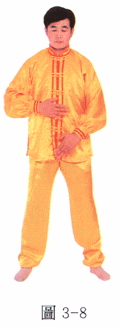
Shuang Shou Tui Dong Falun (Turning Falun with Two Hands)
After completing the double-hand movements, move both hands
downward past the face and over the chest until they reach the location of the
lower abdomen. Now turn Falun at the lower abdomen (as shown in Fig. 3-7, 3-8
and 3-9) with the left hand inside for males and the right hand inside for
females. Keep a distance of 3 cm (1 inch) between the two hands and between
the inner hand and the lower abdomen. Turn Falun clockwise (viewed from the
front) four times to spin the energy from the outside back into the inside of
the body. While turning the Falun, keep the movements of the two hands within
the area of the lower abdomen.
 
Liang Shou Jieyin (as shown in Fig. 3-10)
4. Falun Zhou Tian Fa (Falun Heavenly
Circulation Exercise)
Principle:
This exercise enables energy of the human body to circulate
over large areas. Rather than going through only one or several channels, the
energy circulates from the whole Yin side of the body to the Yang side over
and over again. This exercise is much superior to the average methods of
opening up the energy channels, or, the great and small heavenly circulation.
It is an intermediate-level exercise of Falun Gong. On the basis of the
previous three sets of exercises, this one is intended to open up all the
energy passages throughout the body (including the great heavenly circuit), so
that energy channels will be gradually connected throughout the whole body
from the top to the bottom. The most outstanding feature of this exercise is
to use the rotation of Falun to rectify all the abnormal conditions of the
human body, so that the human body, the small cosmos, returns to its original
state and the energy of the whole body can circulate freely and smoothly. When
reaching this state, the practitioner will have achieved a very high level of
cultivation of Shi-Jian-Fa (In-Triple-World-Fa). Those with great
inborn quality can begin their cultivation of the Dafa (Great Law). At
this time, their energy potency and divine powers will grow dramatically. In
doing this exercise, move the hands along with the Qiji (energy mechanism).
Each movement is unhurried, slow and smooth.
Kou Jue (Verse recited once right before the exercise)
Xuan Fa Zhi Xu Xin Qing Si Yu
Fan Ben Gui Zhen You You Si Qi
Preparation:
Relax the entire body but not too loose. Stand naturally
with feet shoulder-width apart. Bend the knees slightly. Keep the knees and
hips relaxed. Pull your chin in slightly. The tip of the tongue touches the
upper palate. Leave a little space between the teeth. Close the lips and
gently shut the eyes. Maintain a serene expression on the face.
   
Shuang Shou Jieyin (conjoin the hands) (as shown in
Fig. 4-1) and then Heshi (put them together) in front of the chest(as
shown in Fig. 4-2).
Separate the two hands from the Heshi position. Move them
down toward the lower abdomen while turning both palms to face the body. Keep
a distance of about 10 cm (4 inches) between the hands and the body. After the
hands have passed along the lower abdomen, stretch them further downward along
the inner sides of the two legs. At the same time, bend at the waist and squat
down (as shown in Fig. 4-3).
When the fingertips are close to the ground, slide the
hands along the outside of both feet to draw a circle from the front of each
foot to the outside of the heel (as shown in Fig. 4-4).
Then bend both wrists slightly and lift the hands up along
the back of the legs (as shown in Fig. 4-5).
Straighten the spine while lifting the hands up along the
back (as shown in Fig. 4-6). During the exercise, do not let the two hands
touch any part of the body; otherwise, the energy on both hands will be taken
back into the body.
When the hands can not be lifted any higher, make hollow
fists (as shown in Fig. 4-7), then pull the hands forward passing through the
underarms.
Cross the two arms in front of the chest; (There is no
special requirement for which arm is above or which arm is below. It depends
on one’s habit. This is the same for both males and females) (as shown in
Fig. 4-8).
 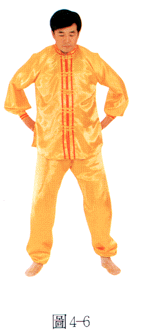 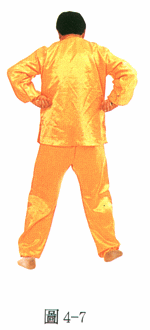 
Open the hollow fists and place the two hands over the
shoulders (leaving a gap). Move both hands along the Yang side (the
outside) of the arms. When reaching the wrists, turn the hands so palms
face each other at a distance of 3-4 cm (1 inch). That is, the outer thumb is
now turned to be on top and the inner thumb is below. At this time, the hands
and the arms form a "straight line" (as shown in Fig. 4-9).
Turn both palms as if holding a ball, that is, the outside
hand turns inside and the inside hand turns outside. As both hands push along
the Yin sides (the inside) of the lower and upper arms, raise them up
and over the back of the head. The hands remain in a crossed position at the
back of the head (as shown in Fig. 4-10).
 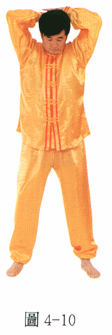 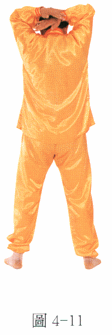 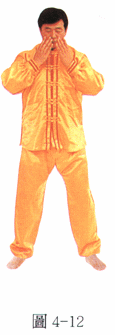
Then, continue to move the hands further down toward the
backbone (as shown in Fig. 4-11).
Separate the two hands, with fingertips pointing downward,
and connect with the energy of the back. Then move both hands in parallel over
the top of the head to the front of the chest (as Fig. 4-12). Thus, a heavenly
circuit is completed. Repeat the movements nine times. After completing the
exercise, move the two hands down along the chest to the lower abdomen.
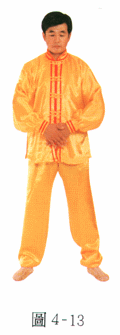 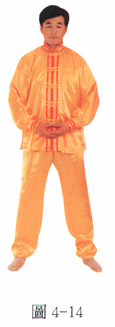
Die Kou Xiao Fu (overlap the two hands in front of the
lower abdomen) (as shown in Fig. 4-13), and Shuang Shou Jieyin (conjoin
the two hands) (as shown in Fig. 4-14).
5. Shen Tong Jia Chi Fa (Strengthening Divine
Powers Exercise)
Principle:
The Strengthening Divine Powers Exercise is a tranquil
cultivation exercise in Falun Gong. It is a multi-purpose practice intended to
strengthen one’s divine powers (including supernormal capabilities) and
energy potency by turning Falun with the Buddha’s hand gestures. This is an
above intermediate-level exercise and was originally kept as a secretive
practice. In order to meet the requests of practitioners with a substantial
foundation, I especially make public this cultivation method to save those
predestined practitioners. This exercise requires sitting with both legs
crossed. The full-lotus position is preferred though the half-lotus position
is also acceptable. During the practice, the flow of Qi is strong and the
energy field around the body is quite large. The hands move to follow Qiji (
the energy mechanism) installed by the master. When the hand movements
start, the heart follows the movement of the thoughts. When strengthening the
divine powers, keep the mind empty, with a slight focus on both palms. The
center of the palms will feel warm, heavy, electric, numb, as if holding a
weight, etc. Nevertheless, do not pursue any of these sensations
intentionally, just let it happen naturally. The longer the legs are crossed,
the better, and it depends on one’s endurance. The longer one sits, the more
intensive the exercise is and the faster the energy grows. When doing this
exercise, (Do not think of anything. There is no mind intent) ease into
tranquillity. Gradually enter into the state of Ding (deep tranquillity)
from the dynamic state which is seemingly tranquil but not Ding. However, your
main consciousness must be aware that you are practicing.
Kou Jue (Verse recited once right before the exercise)
You Yi Wu Yi Yin Sui Ji Qi
Si Kong Fei Kong Dong Jing Ru Yi
Liang Shou Jieyin (Conjoin the Hands)
Sit with legs crossed in lotus position. Relax the entire
body, but not too loose. Keep the waist and neck upright. Draw the lower jaw
in slightly. The tip of tongue touches the upper palate. Leave a space between
teeth. Close the lips. Gently shut the eyes. The heart fills with compassion.
Assume a peaceful and serene expression on the face. Jieyin at the lower
abdomen, and gradually ease into tranquillity (as shown in Fig. 5-1).
First Hand-Gesture
When the hand movements start, the heart follows the
movement of the thoughts. Movements should follow the Qiji (energy
mechanism) installed by the master. They should be carried out
unhurriedly, slowly and smooth. Slowly raise both hands in the state of
"Jieyin" until reaching the front of the head. Then, gradually turn
the palms to face upward. When the palms are face-up, the hands have also
reached the highest point (as shown in Fig. 5-2).
Then, separating the two hands, draw an arc over the head,
rotating toward the sides until reaching the front side of the head (as shown
in Fig. 5-3).
Immediately after, slowly drop both hands. Try to hold the
elbows inward, with palms facing up and fingers pointing toward the front (as
shown in Fig. 5-4).
Next, flex both wrists and cross them in front of the
chest. For males, the left hand travels outside, for females, the right hand
travels outside (as shown in Fig. 5-5).
  
When a "straight line" is formed by the arms and
hands, the wrist of the hand on the outside rotates outwardly, with the palm
turned to face upward. Draw a semicircle, and turn the palm to face up with
fingers pointing toward the back. The hand uses a little force. The palm of
the hand that is inside, after crossing over in front of the chest, turns to
face downward. Straighten the arm. Rotate the arm and hand so the palm faces
outward. The hands and arms in the lower front of the body should form an
angle of 30 degrees with the body (as shown in Fig. 5-6).
 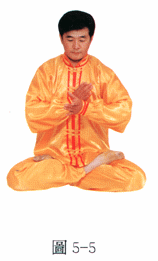 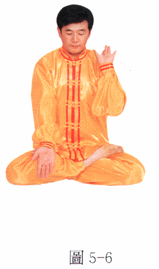
Second Hand-Gesture
Following the previous position (as shown in Fig. 5-6), the
left hand (the upper hand) moves to the inside. The palm of the right hand
turns toward the body as the right hand moves up. The movement is the same as
in the first gesture with the left and right hands switched. Hand positions
are exactly opposite (as shown in Fig. 5-7).
Third Hand-Gesture
Straighten the right wrist for males (left for females)
with the palm facing the body. After the right hand moves across in front of
the chest, turn the palm to face down and move down till the lower front where
the shin is located. Keep the arm straight. The left wrist for males (right
for females) turns while moving up and crossing the right hand so the palm
faces the body. At the same time, move the palm toward the left (right for
females) shoulder. When the hand has reached its position, the palm faces up
and the fingers point to the front (as shown in Fig. 5-8).
 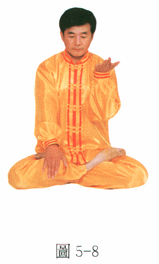 
Fourth Hand-Gesture
It is the same gesture as shown above with hand positions
switched. The left hand for males (right for females) moves on the inside, and
the right hand (left for females) moves on the outside. The movements are just
alternating the left with the right hand. The hand positions are opposite (as
shown in Fig. 5-9). All four hand-gestures are done continuously and without
stopping.
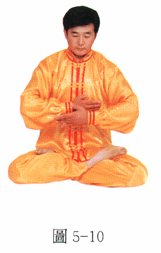 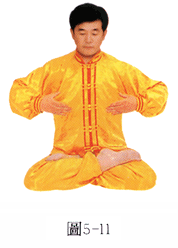
Strengthening Sphere-Shaped Divine Powers
Continuing after the fourth hand-gesture, the upper hand
moves on the inside with the lower hand moving on the outside. For males, the
right palm gradually turns and moves down toward the chest area. The left hand
for males (right for females) moves up. When both forearms have reached the
chest area forming a straight line (as shown in Fig. 5-10), pull the hands
apart toward the sides (as shown in Fig. 5-11) while turning the palms to face
downward.
When both hands reach above the outside of the knees, keep
the hands at the level of the waist. The forearms and the wrists are at the
same level. Relax both arms (as shown in Fig. 5-12). This position is to draw
the internal supernormal powers out into the hands to be strengthened. They
are the sphere-shaped supernormal powers. When strengthening the supernormal
powers, the palms will feel warm, heavy and numb, as if holding a weight. But
do not pursue these sensations intentionally. Let it happen naturally. The
longer the position is held, the better, until one feels too tired to endure
it.
 
Strengthening Pillar-Shaped Divine Powers
Following the previous position, the right hand (left for
females) rotates so the palm faces upward, and at the same time, moves toward
the lower abdomen area. When the hand has reached its position, the palm stays
at the lower abdomen with the palm facing up. At the same time, when the right
hand is moving, lift the left hand (right for females) and simultaneously move
it toward the chin. With the palm still facing downward, keep the hand as high
as the chin. The forearm and the hand are at the same level. At this time,
both palms face each other and stay still (as shown in Fig. 5-13). This is
strengthening pillar-shaped supernormal powers, such as "palm
thunder", etc. Hold the position until you feel that it is impossible to
hold it anymore.
Then, the upper hand draws a semicircle in front and drops
to the lower abdomen area. At the same time, lift the lower hand while turning
the palm to face down, until it is right below the chin (as shown in Fig.
5-14). The arm is at the same level as the shoulder, with the two palms facing
each other. This also strengthens the supernormal powers, only with the
opposite hand positions. Hold the position until the arms become too tired to
endure it.
Tranquil Cultivation
From the previous position, the upper hand draws a
semicircle down to the lower abdomen area. Liangshou Jieyin (as shown in Fig.
5-15), and start the tranquil cultivation. Stay in Ding (tranquil yet
conscious state of mind); the longer the better.
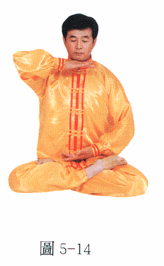  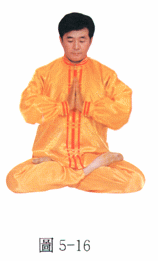
Ending Position
Heshi (as shown in Fig. 5-16). Come out of Ding and end the
cross-legged sitting.
Some Basic Requirements and Words of Caution
for Practicing Falun Gong
1. The five sets of exercises of Falun Gong can be
practiced consecutively or selectively. However, usually it is required that
you begin practice with the first set of exercises. Moreover, it would be best
to do the first set of exercises three times. Certainly, the other sets may
still be practiced without doing the first one. Each set can be practiced
individually.
2. Each movement should be carried out with accuracy and
clear rhythm. The hands and arms should move smoothly, up and down, back and
forth, left and right. Following the Qiji (energy mechanism), move
unhurriedly, slowly and smoothly. Do not move too fast or too slow.
3. You must keep yourself under the control of your main
consciousness during practice. Falun Gong cultivates the main consciousness.
Do not deliberately seek swaying. Contain the swaying of the body when it does
happen. You may open your eyes if you have to.
4. Relax the entire body, particularly in the areas of the
knees and hips. The energy channel will become obstructed if you stand too
rigidly.
5. During the exercises, the movements should be relaxed
and natural, free and extended, easy and unencumbered. The movements should be
firm yet gentle, with some power yet no rigidity or stiffness. Doing so will
result in noticeable effectiveness.
6. Everytime when you are finished practicing, you end the
movements but not the Gong. You only need to Jieyin (conjoin the hands).
The end of Jieyin means the end of the movements. Do not put an end to the
Gong using intention because Falun can never stop rotating.
7. Those who are weak or chronically ill may practice
according to their conditions. They may practice less or choose to do any of
the five sets. For those who cannot perform movements, they may practice the
sitting in the lotus position instead. However, you should continue to
practice.
8. There are no special requirements in terms of the
location, time or direction during practice. However, a clean site and quiet
surroundings are recommended.
9. These exercises are practiced without using any
mindwill. You will never go deviant. But, do not mix Falun Gong with any other
system of cultivation. Otherwise, the Falun will become deformed.
10. When you find it really impossible to enter into
tranquillity during practice, you may chant the name of the master. As time
passes, you will be able to gradually enter into the state of tranquillity.
11. Some tribulations may come up during practice. That is
one way of paying off the karma. Everybody has karma. When you sense
discomfort in your body, do not think of it as an illness. In order to
eliminate karma and to pave the way for cultivation, some tribulations may
come sooner and earlier.
12. If you cannot cross your legs for the sitting exercise,
you may first practice this set by sitting on the edge of a chair. The same
effectiveness can also be achieved this way. But as a practitioner, you must
be able to do the lotus position. As time progresses, you shall certainly be
able to do it.
13. In doing the tranquil exercise, should you see any
pictures or scenes, pay no attention to them, and go on with your practice. If
you are interfered with by some terrifying scenes or feel threatened, you
should immediately remember, "I am protected by the master of Falun Gong.
I am not afraid of anything." Alternatively, you may also call out the
name of Master Li, and continue on with your practice.

 
|